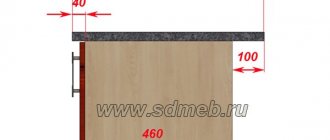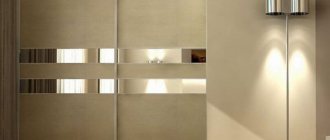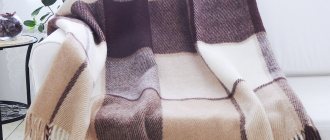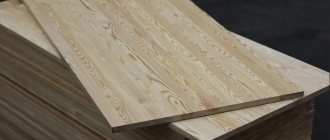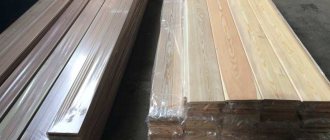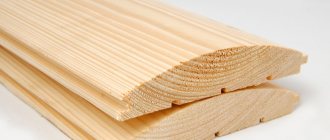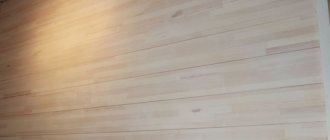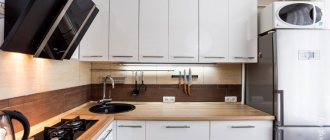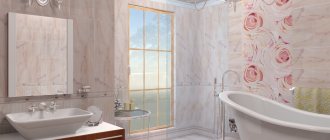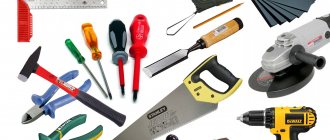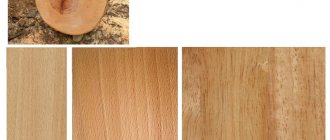To decorate the walls of a building, materials are increasingly being used that do not require special installation skills, while at the same time decorating the surface in an original way and reliably protecting it from external influences.
A popular trend is the technology of suspended structures, a feature of which is the presence of a ventilated gap between the wall and the covering. The ventilation façade elements are fastened to the sheathing.
House panels, which have the appearance of lining, are widely used both for interior decoration and for the exterior design of external walls.
A block house can be made of natural wood, or it can be vinyl or metal; the sizes of each type of house panels are different.
Features of the block house profile
Many consider the block house to be a special type of lining with a rounded front part. In fact, the scope of application and manufacturing technology of this material are similar to lining, but the block house is a facing profiled board that imitates a rounded log.
This material came to Russia from the West. Translated from English, “blockhouse” means block house. A block house is what we call a frame house. Covering the walls with block house boards allows you to create an imitation of a wooden house built from rounded logs.
Each board has a special profile. On its back side, longitudinal grooves are made by milling. Their purpose is to remove moisture and ventilate the skin, relieving stresses arising due to sudden changes in temperature and humidity. Many modern profiled wood materials have such structural elements.
The back side of the block house.
An important detail of a house block is a high-quality lock, which is a connecting tongue and groove.
This connection of panels provides:
- no gaps between cladding elements;
- the ability to hide fastening parts - clamps, nails or screws are hidden by the next board;
- reduction of finishing time.
Quantity of finishing material
Today, wood panels are one of the most sought-after and popular materials for finishing a wide variety of rooms. To begin finishing work, you must first calculate exactly how much material you will need for construction work. Calculations must be made accurately so as not to buy excess material.
Horizontal clapboard trim
Interior finishing
To determine the amount of lining for interior decoration, it is necessary to divide the square footage into separate areas. Thus, you can calculate the plane in the form of a simple figure - a rectangle. The length of the panels plays an important role, because it can be different, so you need to measure the length of all available segments.
- We measure the width and, of course, the length of the room being finished. It is also necessary to find out the area of the upper surface, that is, the ceiling, if you are going to trim it with clapboard.
- We determine the length and height of the wall to find out its total area. Typically, rooms have two opposite walls with identical arcs to each other, so the dimensions of one wall are enough for an accurate calculation.
- Let's sum up the numbers obtained. Don’t forget to subtract the square footage of the openings in the room or room to make it easier to imagine the entire calculation, you can watch the video.
Facade finishing
If you decide to finish the facade of a building, for example, to provide high-quality finishing to the pediment, then the calculations will be similar. If you do the finishing yourself and with your own hands, the only problem in the construction process may be calculating the area of the pediment.
Let's break it down point by point:
Facade covered with clapboard
- The sheathed area is determined similarly to internal calculations.
- To calculate the area of the pediment, you need to multiply the length of the base by its height and then divide it in half.
- We add up all the results obtained and do not forget to subtract the area of all openings from this sum.
In addition
Now you know how many boards are in a cube of lining and the number of meters in a cubic meter, and this is already 50% of success. Accurate calculations guarantee you savings when purchasing material and eliminate problems when installing the lining.
Different lengths of lime lining
Wood species used for the production of block houses
Almost any wood is suitable for manufacturing. The most popular types of wood are spruce or pine. It is possible to use hardwoods as raw materials: oak, linden, aspen, alder.
Block house made of pine.
Angara pine has impeccable performance characteristics. This material belongs to the luxury class. It has no falling knots, is well processed, and has an attractive shade. As a rule, such boards are used for finishing solid and expensive houses.
A block house made of larch is well appreciated. The boards have a characteristic whitish tint and are not susceptible to destruction by pathogenic flora. In addition to cladding houses, larch material is often used for cladding baths. Its wood does not release resin at high temperatures, which eliminates skin burns and damage to the appearance of the wall.
Block house made of larch.
Due to the higher price, profiled oak boards are used less frequently. Although oak wood is aesthetically pleasing and durable, its grain pattern becomes dull over time. To maintain the attractive appearance of such cladding, it is necessary to properly care for it.
Due to the low strength characteristics and reduced durability of the cladding, dead wood or firewood is not used for the manufacture of panels. The forest selected for processing must be healthy and alive.
How many boards are in 1 cube: performing the calculation
Any person, even from his school days, understands how cubic capacity is calculated. For this procedure, it is necessary to calculate quantities such as: length, width and height. A similar principle is used to calculate the cubic capacity of 1 board. When performing such calculations, it is recommended to convert all available values into meters. The cubic capacity of 1 board, which has a cross-section of 150x20 mm. and a length of 6 m, is calculated as follows: 0.15 multiplied by 0.02 and 6, so that the cubic capacity of this board will be 0.018 cubic meters.
Let's apply the volume formula V= L*h*b (where L is length, h is height, b is width).
L= 6.0; h= 0.02; b= 0.15.
Thus, V= 6.0*0.02*0.15 = 0.018 m3.
To determine how many boards are in one cube: divide 1 m3 by cubic capacity (the volume of one board).
1 m 3 / 0.018 m 3 = 55.55 pcs.
Thus, the number of boards in one cube is 55.5 pieces.
Finding out the cost of a certain type of board when the values of its volume is known is quite easy: 0.018 multiplied by the price of 1 cubic meter. When 1 cube of a certain type of board costs, for example, 5,500 rubles, then the cost will be 99 rubles. At this point in the calculation, there is some trick of sellers and managers in construction stores, because the cubic capacity of the material is rounded to some integer values.
Such rounding can lead to such a moment that the price of 1 board (when 1 cube costs 5500) will be completely different values. In addition to all this, it should be noted that various boards for construction, which have a nominal length of 6 meters, actually have a length of 6.1 - 6.2 m, which is not taken into account when selling this building material. This also applies to the purchase of a significant number of boards. This can be seen quite clearly if we use a 150x20 mm board as an example. The number of boards in a cube is 55.5 pcs. But, in a cube they count 55 pieces, which when performing the calculation will have a value of 0.99 cubic meters. In fact, it follows from this that the overpayment for 1 cubic meter of this popular building material can amount to 1% of the real price. For example, 5500 instead of 4995 rubles.
To calculate the cubic capacity for a continuous type of board, slightly different methods are used. When we are talking about buying 1 board, then measuring its thickness, as well as the total length, is carried out in the same way as when choosing edged building material. In this case, the average width is taken for calculations - between a large value and a small one.
For example, when the width of the board at one end is 25 cm, and at the other 20, then the average value will be approximately 22 centimeters. When it is necessary to calculate the volume of a significant number of similar boards for construction, then you will need to lay them out so that the wide one does not differ from the narrow one, more than 10 cm. The main length of this material in the laid out stack should be approximately the same. After this, using a regular tape measure, an accurate measurement is made of the height of the entire existing stack of boards, and the width is measured (approximately in the very middle). The result obtained will then need to be multiplied by a special coefficient, amounting to a value from 0.07 to 0.09, directly dependent on the existing air gap.
Block house production technology
The blank for making the material is a board obtained after sawing logs. The production process is divided into 4 stages.
Log sawing
Logs of suitable size are pre-selected. First, they are sawn into boards using the “square in a circle” technology. It received this name due to the fact that the result of sawing is a square beam and side external elements. It is the latter that go into making a block house. Next, the blanks are transferred to other machines and modified in width.
Scheme of sawing a log.
Drying workpieces
The resulting boards are placed in chamber drying units. This allows the wood moisture content to be reduced to the norm of 12%. When this parameter is reached, the material becomes resistant to the negative effects of the environment - precipitation in the form of rain and snow. In addition, drying prevents the formation of blue stains in the wood.
Loading boards into the dryer.
Trimming and planing boards
The most important stage, during which the modified workpieces are processed using high-tech modern equipment. Fastening elements - tenons and grooves - are cut with high precision, and air channels are made. Since at this stage the board already has a perfectly polished surface, no additional processing is required.
Machine for making block house profiles.
Sorting and packaging
The resulting block house is sorted by quality class - appearance. After this, the material is securely packaged in film.
Packed block house.
How to calculate the cubic capacity of a board?
So, in the product catalog of a particular store it is indicated, for example, that edged boards 40x100x6000 are available for sale. These values - in millimeters - are converted to meters: 0.04x0.1x6. It will also help to correctly calculate by converting millimeters to meters using the following formula after calculations: a meter contains 1000 mm, a square meter already contains 1,000,000 mm2, and a cubic meter contains a billion cubic millimeters. Multiplying these values, we get 0.024 m3. Dividing the cubic meter by this value, we get 41 whole boards, without cutting the 42nd. It is advisable to order a little more than a cubic meter - and the extra board will be useful to you, and the seller does not need to cut the last one into pieces and then look for a buyer for this scrap. With the 42nd board in this case, the volume will be equal to a little more than a cubic meter - 1008 dm3 or 1.008 m3.
The cubic capacity of the board is also calculated indirectly. For example, the same customer reported an order volume of one hundred boards. As a result, 100 pieces. 40x100x6000 is equal to 2.4 m3. Some clients go exactly this way - the board is used mainly for lining the floor, ceiling and attic floors, for the construction of rafters and roofing sheathing, which means that it is easier to purchase its estimated quantity individually - in a certain quantity - than to count by cubic meters of wood.
Block house varieties and what documents they are regulated by
In our country there are no GOST standards regulating the production of block houses. For this reason, manufacturers focus on those standards that are suitable for specific production conditions. Due to the lack of standards, you can find a wide variety of block house and its varieties on the market.
Most often, domestic manufacturers use the Soviet GOST 8242-88 “Profile parts made of wood and wood materials for construction,” which is used for the production of lining.
In particular, they are guided by its rules regarding:
- permissible geometric deviations when cutting elements;
- processing parameters and surface roughness;
- acceptable product defects;
- humidity criteria (12% - inside, 15% - outside);
- rules for transportation and packaging of products;
- ways to check quality characteristics.
Foreign regulations are more stringent. Many people use the German version of material standardization in accordance with the standards “Solid softwood paneling and cladding - Machined profiles with tongue and groove; German version EN 14519:2005".
This pan-European standard has the name: “Panels and cladding made of solid coniferous wood - with profiled groove and tongue.” This regulation has standards similar to the domestic GOST and provides for the division of block houses into quality classes “A” and “B”.
As for Russia, there is no precise classification of block houses by grade. The names of the categories can be whatever you want (as is more convenient, “Classic”, “grade A or B” or intermediate types - “AB”, there may even be a 3rd grade - C.
Let us give an approximate classification by categories and varieties, which is used most often.
“Extra” grade – the highest
It does not allow the presence of cracks, knots and other small flaws in the material. There are no traces of mechanical processing - the profiled board has an ideal surface on the front side.
Grade "A"
Any mechanical damage to the material is not allowed. On 1 meter of the board there should not be: resin pockets longer than 30 mm, 2 or more knots with a diameter greater than 30 mm.
Grade "B"
Per meter of length, a board may have no more than one mechanical damage on the inside resulting from processing. The presence of knots per 1 meter is no more than 4, diameter up to 30 mm. The surface with knots should be light, the texture of the wood should be vibrant.
Grade "C"
It is possible to have any number of dark and light knots, the diameter of which does not exceed 30 mm.
Products of higher grades have a slightly higher price. They are used to decorate the interior walls of a house or apartment.
What to look for when choosing
To summarize, let’s try to briefly highlight the main points:
- 1. Do not rely too much on the name of the variety that the manufacturer assigned to its products (since there are no uniform standards). Inspect and compare, choose what suits you in terms of price and quality.
- 2. Visually assess the condition of the goods for the presence of rot, falling knots (healthy ones are the norm), through and long end cracks.
- 3. If you have access to a hygrometer, check the humidity.
- 4. By placing the products on flat surfaces, try to determine possible warping.
- 5. Test the operation of the locks - the connection should be easy, but also moderately tight.
- 6. Choose a section depending on where the block house will be used.
- 7. When making calculations for your order, take into account the difference between the total and working width of the lamella.
Block house dimensions
The thickness of the material is measured from the highest point of the front surface perpendicular to the back side. As a rule, a board is made with an optimal cross-sectional proportion - the thickness corresponds to the width of the material. This is how its strength characteristics are maintained, since boards of greater width and insufficient thickness are susceptible to cracking and warping.
When ordering material, it is important to consider that the working and overall width of the block house are divided. After installation, part of the board is hidden - the tenon entering the groove of the adjacent panel is covered by it.
Working width is the part that is visually visible after assembling the shield.
Working size.
Dimensions of a block house for exterior finishing
The requirement for external cladding is resistance to the external environment. Coniferous wood material is used for exterior finishing. The facade is sheathed with boards with a more convex profile.
Block house for exterior finishing.
Most often, panels from 3 to 6 meters long are used for exterior wall cladding, having the following dimensions:
- 140 x 30 mm;
- 142 x 36 mm;
- 190 x 36 mm.
According to standard sizes, boards for external finishing are conventionally divided into:
- universal – 3 or 6 meters long with dimensions 42 x 36 mm;
- wide universal - 2, 3 or 6 meters long with dimensions 142 x 28 mm;
- wide facades - 4 or 6 meters long with dimensions 193 x 36 mm.
The house is finished with a block house.
Installation without insulation
We recommend using it for finishing the external walls of well-insulated buildings. This technology reduces the total estimated cost of construction work and shortens its time. There are no fundamental differences in technology. If, during work with insulation, the installation was carried out precisely for the main lathing, and the counter-lattice was done automatically, then here you need to correctly fix the slats for the block house.
Wall before finishing
Fixed sheathing and installation of block house
Exterior of the house after finishing
The most difficult finishing areas are door and window openings. Work very carefully. Take all measures to prevent water from getting between the wall and the sheathing.
House lined with block house
Tecos
Canadian manufacturer Tecos produces high-quality vinyl flooring imitation block houses. Thanks to the quality characteristics of the products, the company has its consumers in Russia.
Tekos panels have distinctive features:
- the material is resistant to low temperatures;
- the panels are durable and resistant to weather conditions;
- has increased moisture resistance.
The coating has good thermal insulation properties, as well as a variety of colors.
According to the technical characteristics of Tecos vinyl panels, they are determined by the following indicators:
- length - 3780 mm;
- width - 264 mm;
- sheet thickness - 1.2 mm;
- plate weight - 2.03 kg;
- flammability - G2 class.
The panels are laid by the manufacturer in 18 pieces per package.
Types of imitation logs
An alternative to wooden cladding in the form of lining can be a coating made of other materials:
- metal Steel galvanized wood-look siding in the form of clapboard is used to imitate natural wood. The material has high strength, fire resistance, moisture resistance, color brightness, and sun resistance. The disadvantage of the coating is the ability to heat up, thereby providing an increased temperature in the room;
- vinyl. PVC imitation has strength, resistance to moisture, a wide range of colors, low cost, but tends to fade in the sun and is brittle at low temperatures;
- acrylic The ability to withstand sunlight and increased strength distinguishes acrylic panels from vinyl. The material is quite durable and most in demand.
NOTE!
High-quality imitation of wooden lining is achieved through the manufacture of the material in high-tech production.
The use of high-quality polymers and dyes gives the material a visual similarity to wood.
